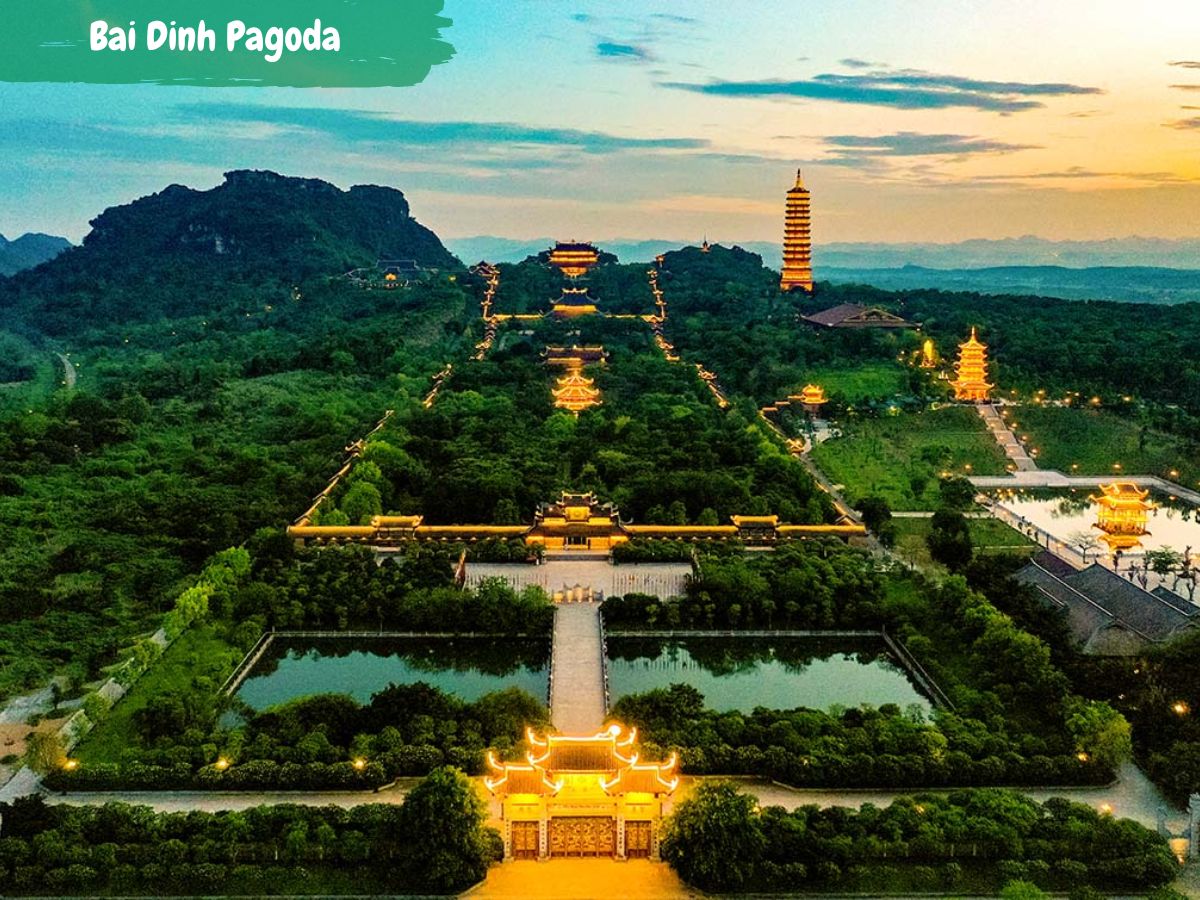Ninh Binh, Travel Guide
Bai Dinh Pagoda – A Spiritual Oasis in Vietnam
Bai Dinh Pagoda is a vast Buddhist temple complex located in Ninh Binh Province, Vietnam. Covering over 600 hectares at the base of Dinh Mountain, it is the largest Buddhist complex in the country. The site combines ancient and modern structures, with the main pagoda constructed in 2003.
Bai Dinh serves as a place of worship, a center for Buddhist studies, and a hub for cultural exchange. The pagoda attracts numerous visitors annually, drawn by its religious significance, architectural beauty, and tranquil surroundings. It houses valuable relics and artifacts, contributing to its status as an important cultural heritage site.
Bai Dinh Pagoda offers visitors an opportunity to explore Vietnam’s rich spiritual traditions and history in a serene setting. As a prominent religious and cultural landmark, Bai Dinh Pagoda plays a crucial role in preserving and showcasing Vietnamese Buddhist heritage. Its expansive grounds, impressive architecture, and spiritual atmosphere make it a key destination for both pilgrims and tourists interested in Vietnam’s cultural and religious traditions.
Key Takeaways
- Bai Dinh Pagoda is one of the largest Buddhist pagodas in Vietnam, located in Ninh Binh province.
- The pagoda holds great historical and cultural significance, as it was built on the site of an ancient pagoda dating back to the 13th century.
- Bai Dinh Pagoda is known for its impressive architectural features, including the largest bronze Buddha statue in Southeast Asia and the tallest bell tower in Vietnam.
- Visitors can participate in various religious practices and rituals at the pagoda, such as praying, making offerings, and participating in Buddhist ceremonies.
- The pagoda is not only a religious site, but also a cultural and spiritual center, attracting visitors from all over the world who seek peace and enlightenment.
History and significance of Bai Dinh Pagoda
The temple is located at the western gateway of the Hoa Lu ancient capital relic complex, in Gia Sinh Commune, Gia Vien District, Ninh Binh Province, 15 kilometers from Ninh Binh City and 95 kilometers from Hanoi. The Bai Dinh Pagoda complex consists of an ancient temple area and a new temple area built since 2003. For many years, this place has become a famous destination, attracting many Buddhists and visitors
Ancient Origins
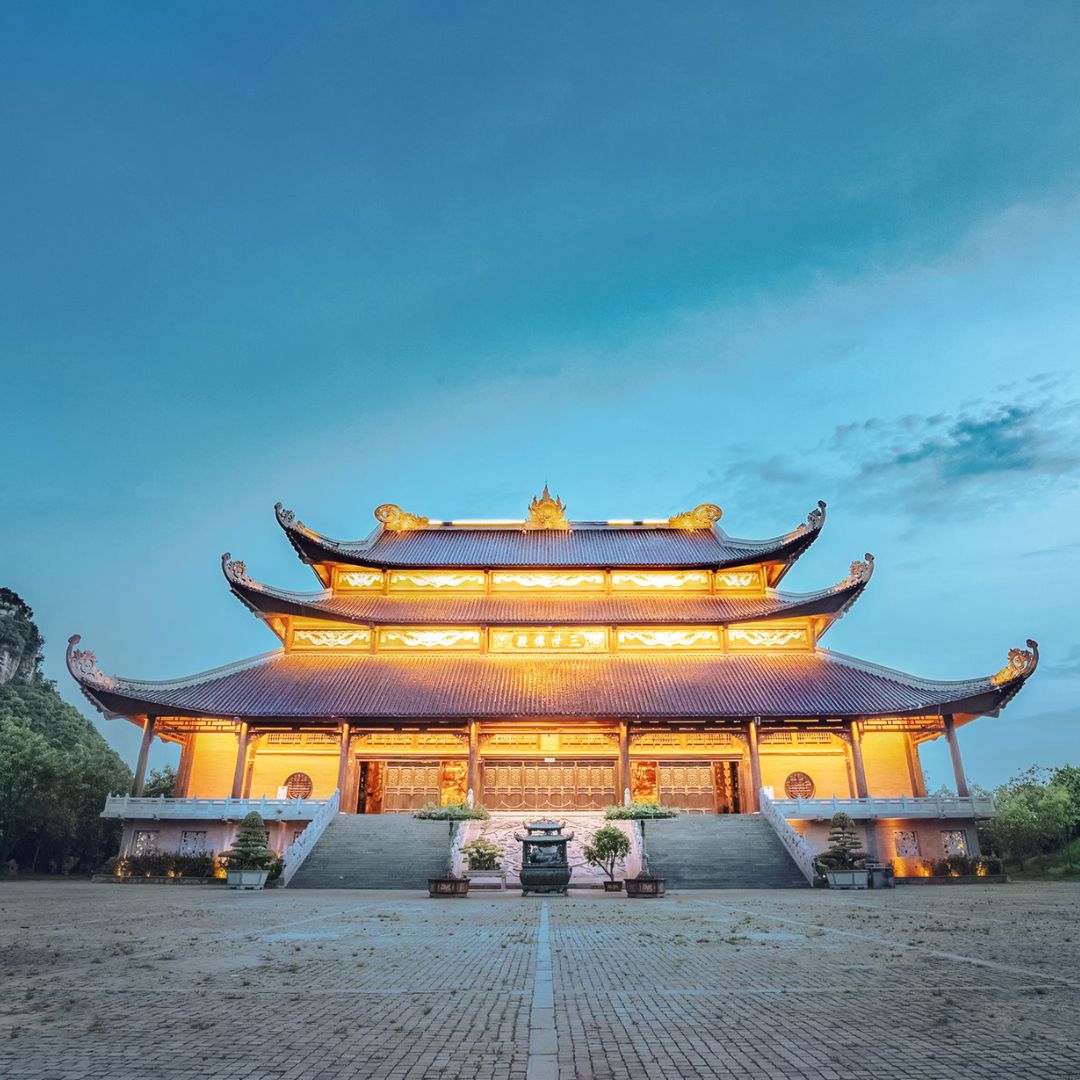
The name Bai Dinh Pagoda means “towards Dinh Mountain,” where many heroic events in Vietnamese history took place. Bai Dinh Mountain is where King Dinh Tien Hoang set up an altar to pray for favorable weather, and it is also the site of the flag ceremony when King Quang Trung marched to Thang Long to defeat the Qing invaders.
The original pagoda was built in the 13th century during the Ly Dynasty, making it one of the oldest pagodas in Vietnam. Over the centuries, the pagoda has undergone several renovations and expansions, with the most significant being the construction of the new main pagoda in 2003.
A Sacred Place for Buddhists
This modern addition has made Bai Dinh Pagoda the largest complex of Buddhist temples in Vietnam, attracting pilgrims and tourists from all over the world. The significance of Bai Dinh Pagoda lies not only in its historical importance, but also in its spiritual and cultural significance. The pagoda is considered a sacred place by Buddhists, who come to pray and seek blessings from the many statues and relics housed within its walls.
The temple is built in the style of cave temples, which is quite common in Ninh Binh. It does not have the soaring curved roofs, large columns, or magnificent upper halls typical of other temples. All the altars dedicated to Buddha and the Mother Goddess are placed within dark caves, enhancing the sacred and mysterious atmosphere of the site. The cave ceilings serve as solid roofs, sheltering the sacred space that has been revered for centuries. Bai Dinh is not only a place for worship but also a beautiful scenic spot. During his visit, King Le Thanh Tong personally inscribed the words “Minh Dinh danh lam” to praise its beauty.
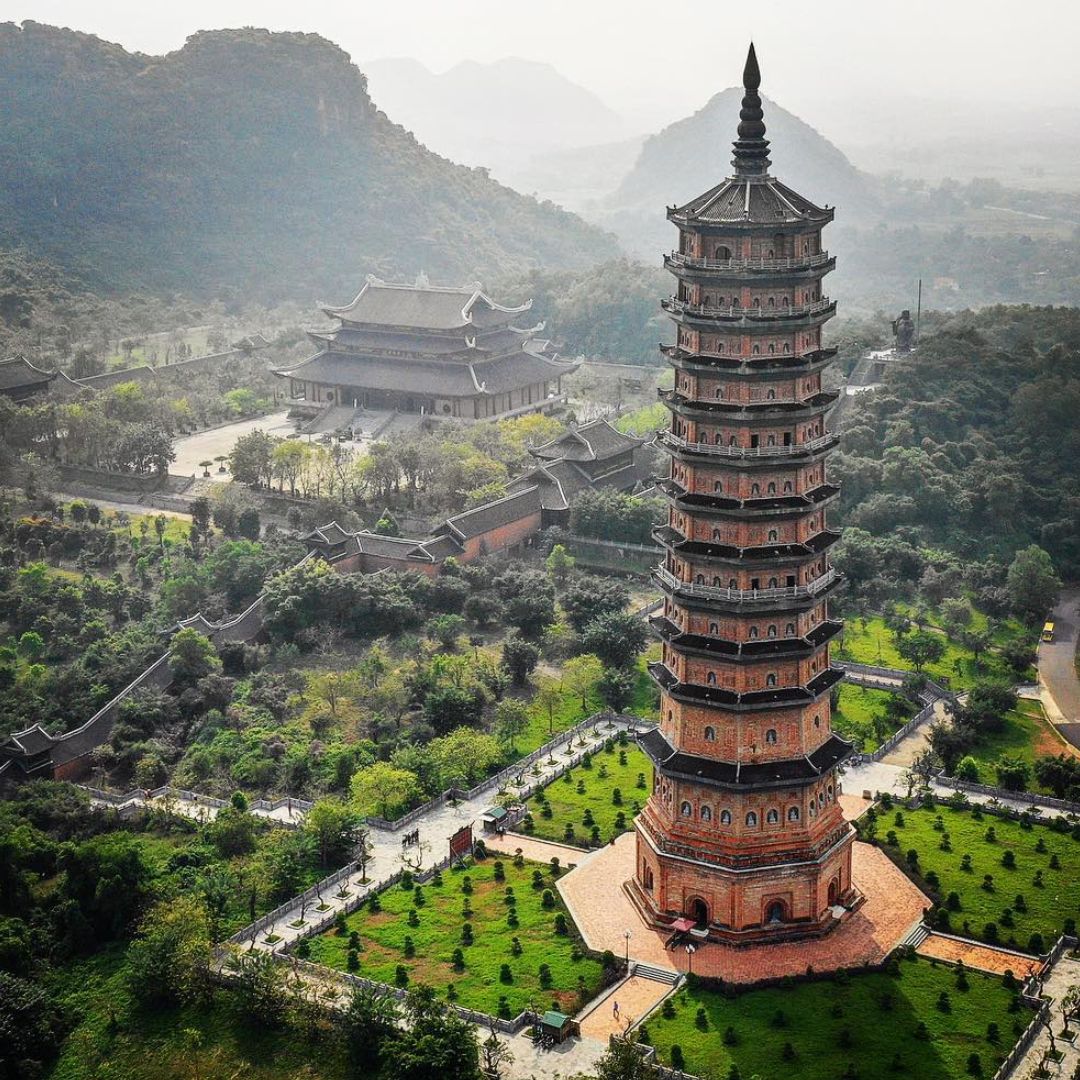
Promoting Vietnamese Culture and Heritage
The pagoda also plays an important role in preserving and promoting Vietnamese culture and traditions, with regular ceremonies and festivals held throughout the year. With its stunning architecture, beautiful surroundings, and rich history, Bai Dinh Pagoda is a symbol of Vietnam’s spiritual and cultural heritage.
In 1997, the ancient Bai Dinh Pagoda was recognized as a national historical, cultural, and revolutionary site. Interestingly, although the temple complex was established during the Dinh Dynasty, it features many architectural details and artifacts that prominently bear the characteristics of the Ly Dynasty.
Architectural features of Bai Dinh Pagoda
Bai Dinh Pagoda is renowned for its impressive architectural features, blending traditional Vietnamese design with modern influences. The main pagoda is an imposing structure, with intricate carvings and ornate decorations adorning its exterior. The pagoda is surrounded by a series of smaller temples, stupas, and statues, creating a visually stunning complex that reflects the rich history and culture of Vietnam.
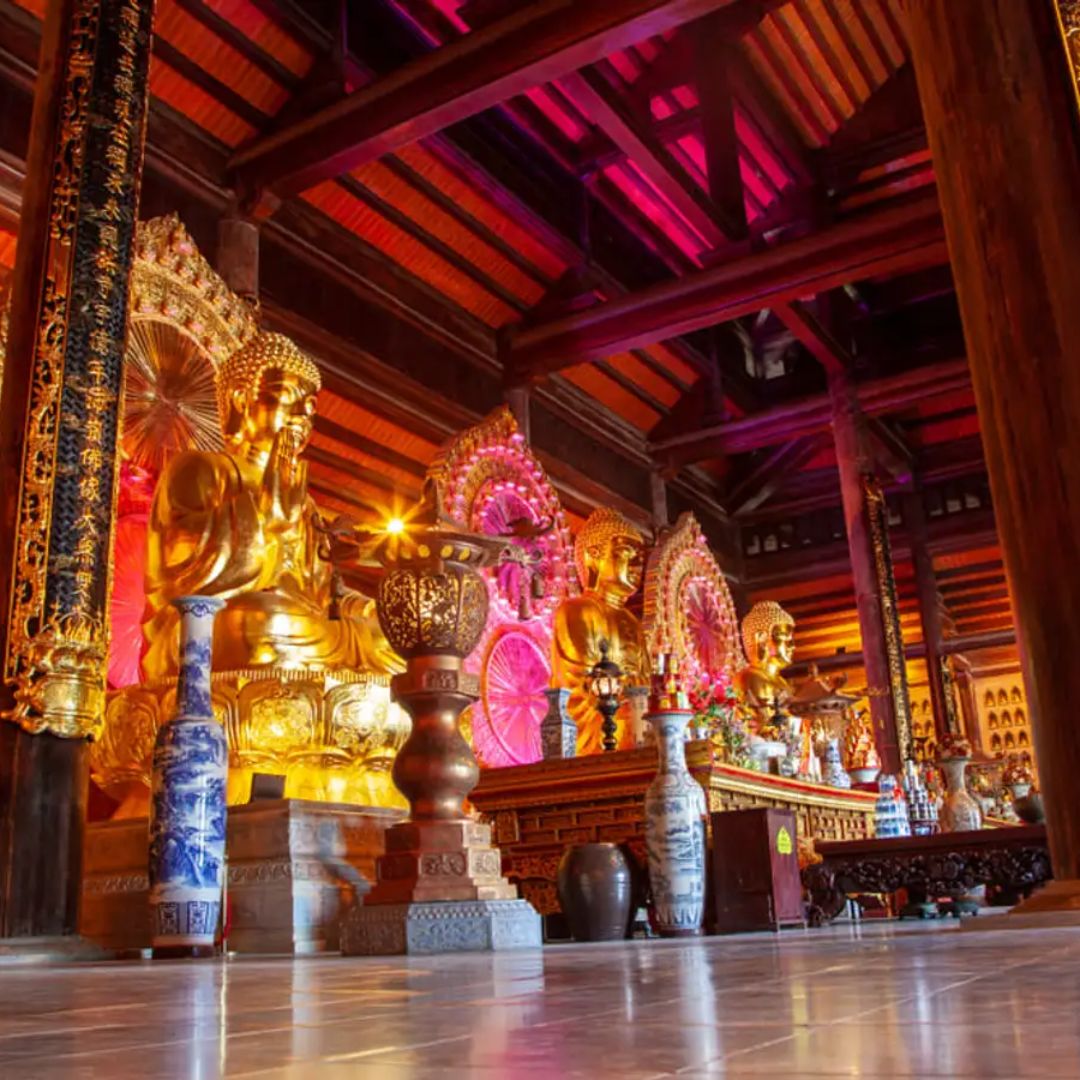
The use of traditional materials such as wood, stone, and ceramic tiles adds to the authenticity and charm of the pagoda, while modern construction techniques ensure its longevity and durability. The main attraction of Bai Dinh Pagoda is the 36-meter tall bronze statue of Buddha Sakyamuni, which is housed within the main hall. This impressive statue is one of the largest of its kind in Vietnam and is a focal point for pilgrims and visitors alike.
Today, Bai Dinh Pagoda is considered the most attractive spiritual tourist destination in Vietnam, boasting several recognized records, such as:
- The largest temple complex in Vietnam (total area of 539 hectares, with the ancient temple area being 27 hectares and the new temple area 80 hectares).
- The temple with the longest Arhat corridor in Asia (nearly 3 km long).
- The temple with the most Arhat statues in Vietnam (500 statues made of green stone, each about 2 meters tall).
- The temple with the largest jade well in Vietnam.
- The temple with the most bodhi trees in Vietnam (100 bodhi trees propagated from the original bodhi tree in India).
- The temple with the largest gold-plated bronze Buddha statue in Asia (a 100-ton bronze statue in the Phap Chu Hall).
- The temple with the largest bronze Buddha statue in Southeast Asia (a 100-ton Maitreya Buddha statue outdoors).
- The temple with the largest bronze bell in Vietnam (a 36-ton great bell in the Bell Tower).
The pagoda complex also features a bell tower, a drum tower, and a large courtyard where ceremonies and festivals are held. The combination of ancient and modern architectural elements makes Bai Dinh Pagoda a unique and captivating destination for anyone interested in exploring the cultural heritage of Vietnam.
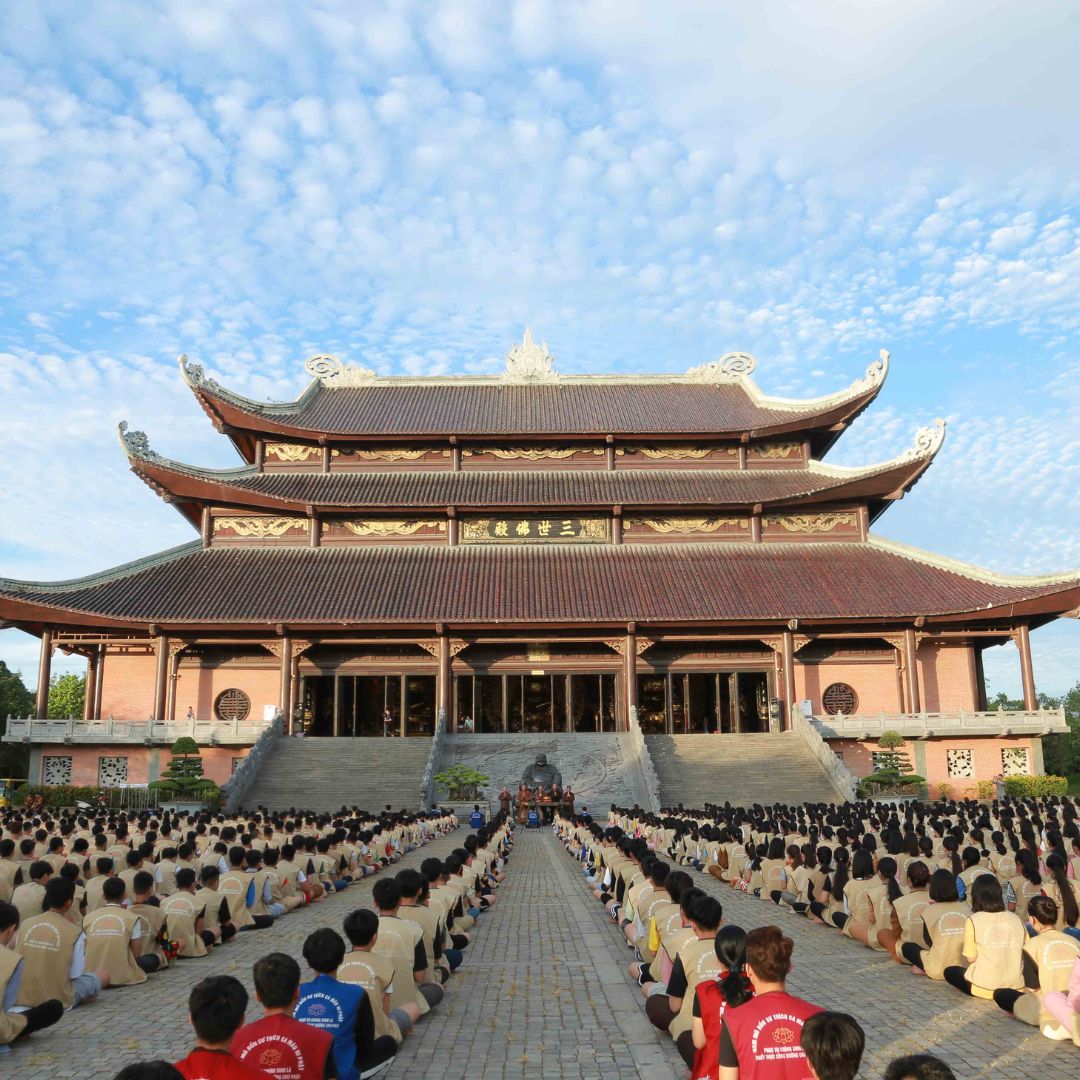
Religious practices and rituals at Bai Dinh Pagoda
Bai Dinh Pagoda is a place of worship for Buddhists, who come to pray, meditate, and seek blessings from the many statues and relics housed within its walls. The pagoda complex is home to numerous shrines dedicated to different Buddhas and bodhisattvas, each with its own unique rituals and practices. Visitors can observe or participate in these rituals, which often involve offerings of incense, flowers, and food, as well as chanting and meditation.
The pagoda also hosts regular ceremonies and festivals throughout the year, including Vesak Day, which commemorates the birth, enlightenment, and death of Buddha. One of the most important rituals at Bai Dinh Pagoda is the act of circumambulation, where pilgrims walk around the main pagoda in a clockwise direction as a form of devotion and respect. This practice is believed to bring good luck and blessings to those who participate.
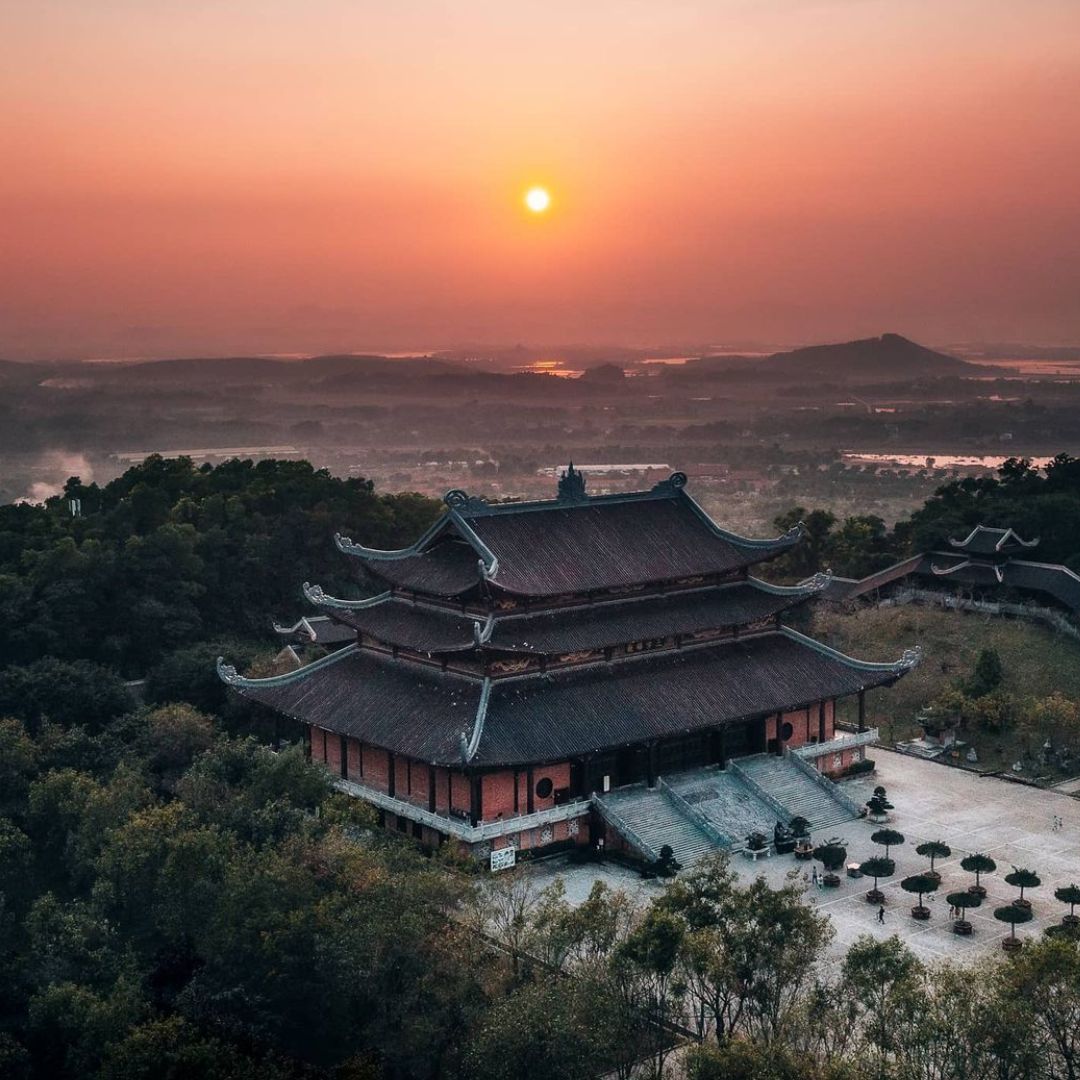
Another significant ritual is the act of making offerings to the Buddha statues, which is believed to accumulate merit and bring about positive karma. These religious practices and rituals are an integral part of the spiritual experience at Bai Dinh Pagoda, allowing visitors to connect with the ancient traditions and teachings of Buddhism.
Cultural and spiritual significance of Bai Dinh Pagoda
Bai Dinh Pagoda holds great cultural and spiritual significance for the people of Vietnam. As a center for Buddhist studies and cultural exchange, the pagoda plays an important role in preserving and promoting Vietnamese traditions and values. The pagoda complex is home to many valuable relics and artifacts, including ancient statues, steles, and scriptures, which are important cultural heritage items.
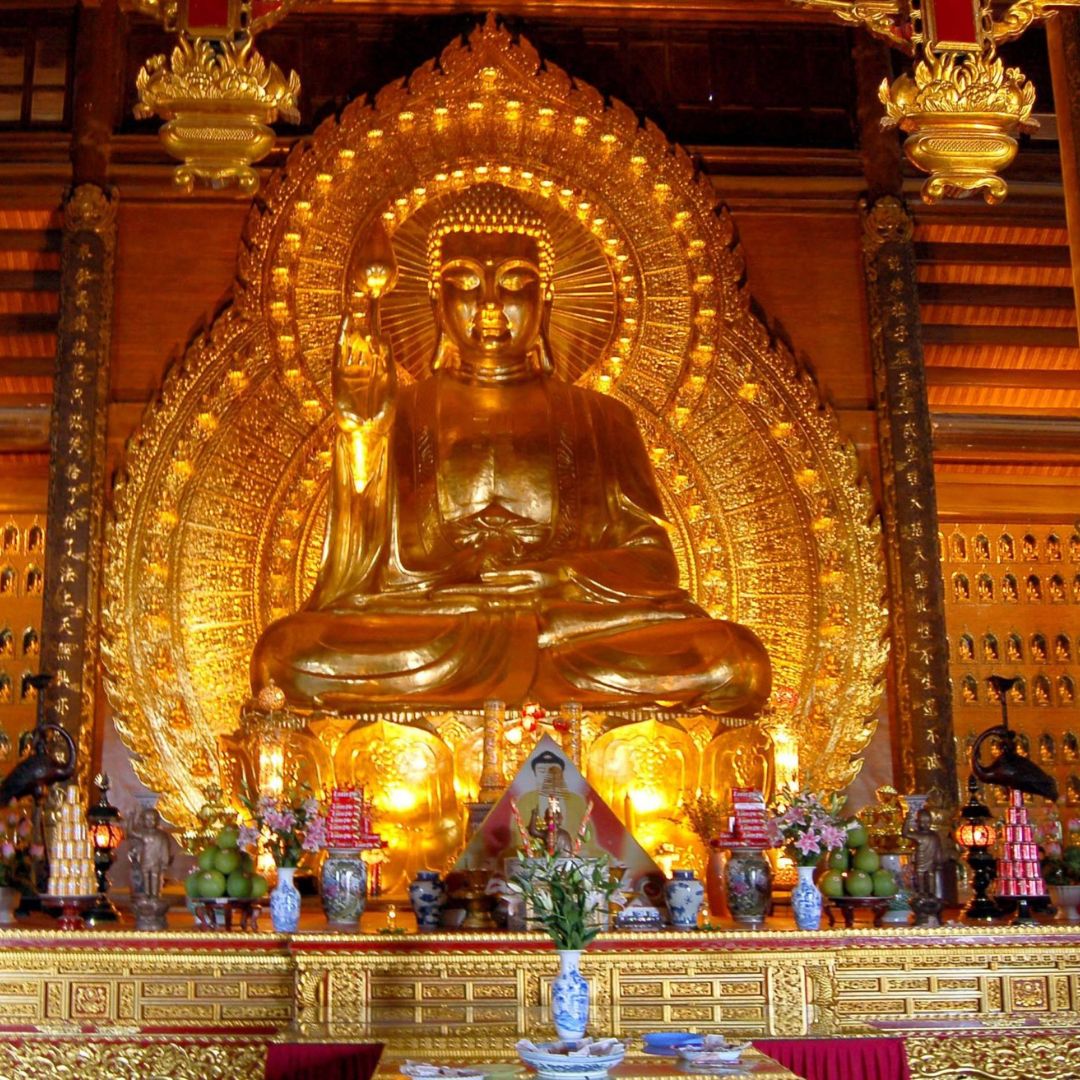
These artifacts provide insight into the history and development of Buddhism in Vietnam, as well as the artistic and architectural achievements of the country. The spiritual significance of Bai Dinh Pagoda lies in its role as a place of worship and pilgrimage for Buddhists. The serene surroundings and peaceful atmosphere make it an ideal location for meditation and contemplation, allowing visitors to connect with their inner selves and find inner peace.
The pagoda also serves as a symbol of unity and harmony, bringing people from different backgrounds together to share in their faith and spirituality. With its rich cultural heritage and spiritual significance, Bai Dinh Pagoda is a testament to the enduring traditions and values of Vietnam.
Visitor experience at Bai Dinh Pagoda
Immersive Natural Surroundings
The pagoda complex is set amidst stunning natural surroundings, with lush greenery, limestone mountains, and tranquil lakes creating a picturesque backdrop for exploration. Visitors can take leisurely strolls through the complex, admiring the beautiful architecture, intricate carvings, and ornate decorations that adorn the temples and shrines.
Architectural Wonders and Spiritual Traditions
The main pagoda is a must-see attraction, with its towering statue of Buddha Sakyamuni drawing visitors from far and wide. In addition to exploring the architectural wonders of Bai Dinh Pagoda, visitors can also participate in various cultural activities and rituals. Many visitors choose to join in the act of circumambulation around the main pagoda or make offerings at the Buddha statues as a way to connect with the spiritual traditions of Vietnam.
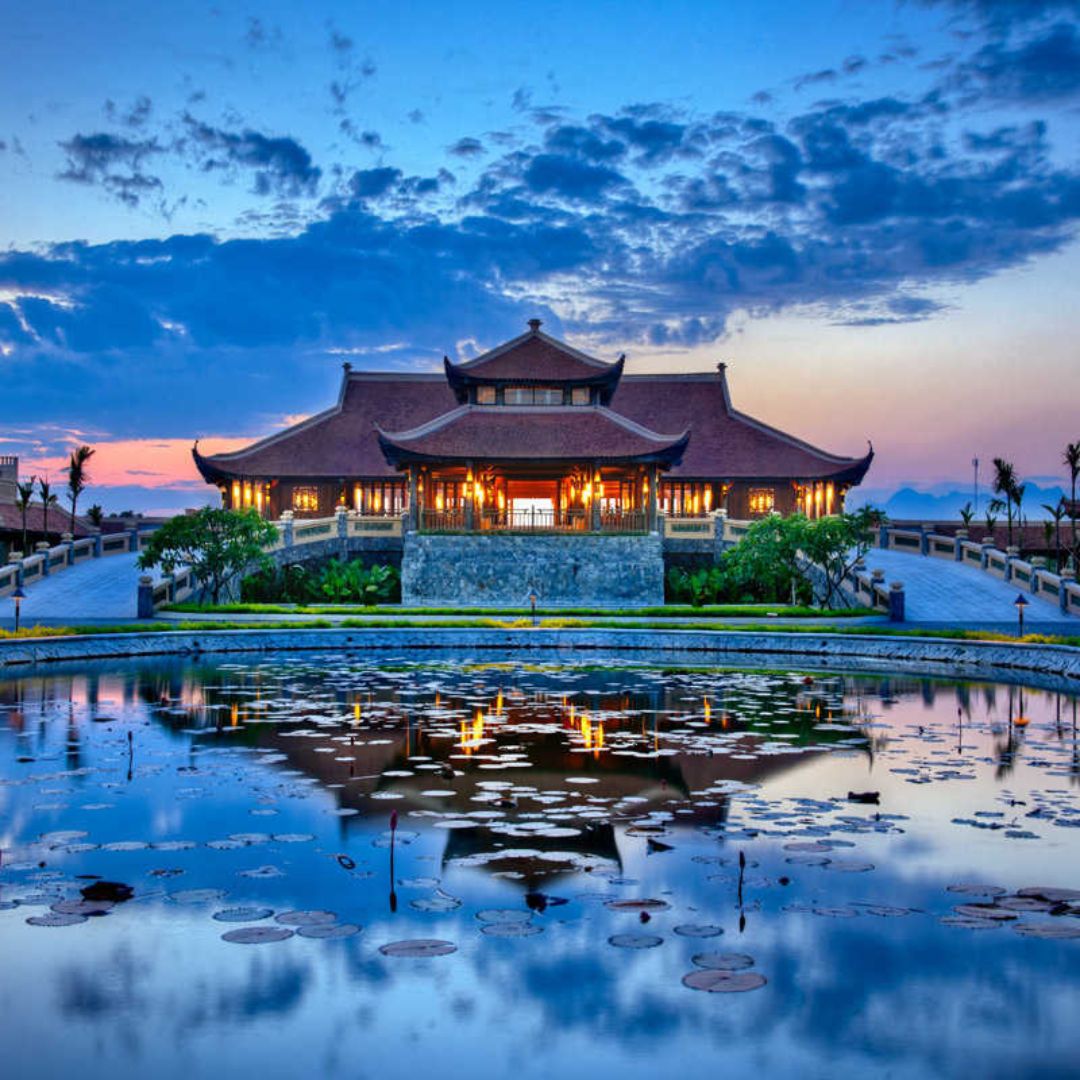
Witnessing Traditional Ceremonies and Festivals
The pagoda complex also hosts regular ceremonies and festivals throughout the year, providing visitors with an opportunity to witness traditional Buddhist rituals and practices. Whether seeking spiritual enlightenment or simply enjoying the serene surroundings, a visit to Bai Dinh Pagoda promises an unforgettable experience for all who venture there.
If you have the opportunity to visit for incense offering, prayer, and religious activities, be sure not to miss the tour of Bai Dinh Pagoda. The temple grounds are vast and connected to the Trang An scenic landscape, so you can combine your visit with additional tours and services at the following costs:
- Electric car rental: 30,000 VND per trip.
- Exploring Trang An scenic landscape: boat ticket is 250,000 VND per person.
- Electric car ticket: 60,000 VND per person.
- Entrance to the Stupa: 50,000 VND per person.
- Tour guide fee: 300,000 VND per tour.
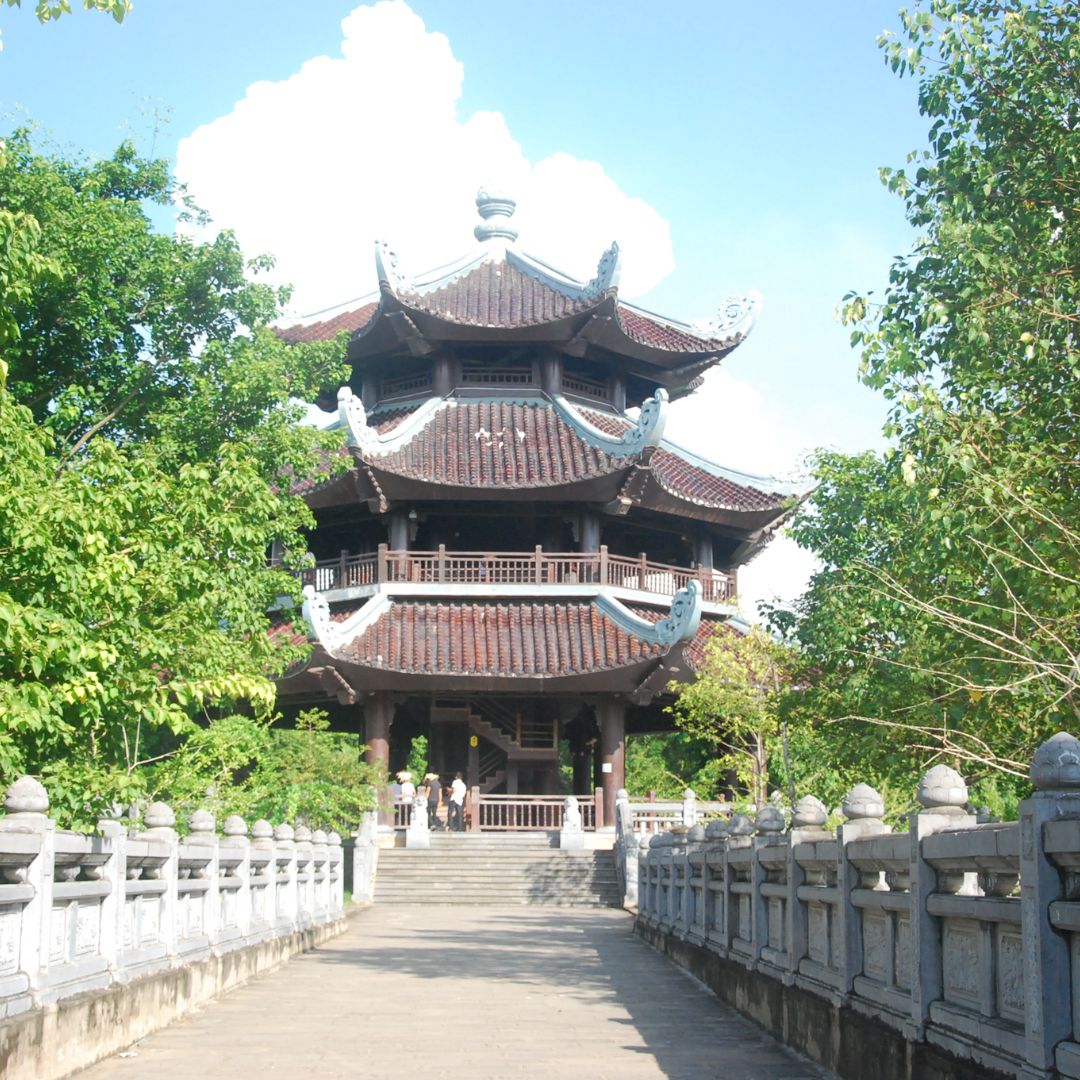
Conservation and preservation efforts at Bai Dinh Pagoda
As one of Vietnam’s most important cultural heritage sites, Bai Dinh Pagoda is subject to ongoing conservation and preservation efforts to ensure its longevity for future generations. The pagoda complex is carefully maintained by a team of dedicated monks and staff who work tirelessly to preserve its historic buildings, artifacts, and natural surroundings. Regular maintenance work is carried out to repair any damage caused by weathering or aging, while efforts are made to protect the site from environmental threats such as pollution or deforestation.
In addition to physical conservation efforts, Bai Dinh Pagoda also benefits from educational programs aimed at raising awareness about its cultural significance. Visitors are encouraged to respect the rules and regulations set out by the pagoda authorities in order to preserve its sanctity and beauty. Efforts are also made to promote sustainable tourism practices that minimize the impact on the environment while allowing visitors to appreciate the cultural heritage of the site.
Through these conservation and preservation efforts, Bai Dinh Pagoda will continue to stand as a symbol of Vietnam’s rich history and spirituality for generations to come.

